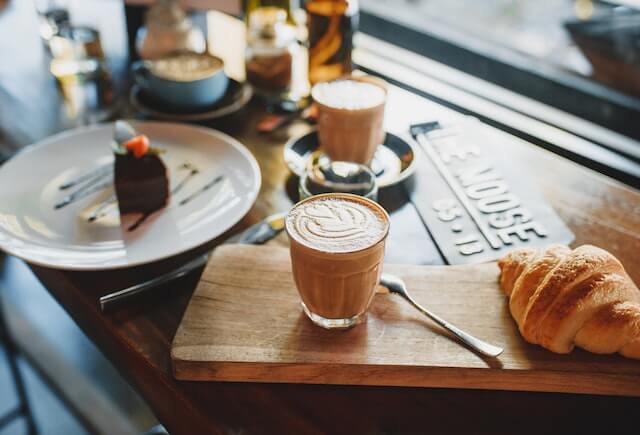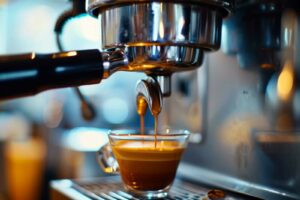Coffee culture is rich with variations, each offering a unique taste and experience. Among the myriad of espresso-based drinks, the Espresso Macchiato holds a special place. It’s not just another coffee; it’s a delicate dance of bold espresso and a touch of frothy milk. But what exactly sets it apart from its caffeinated cousins? Dive in as we unravel the mystique of the Espresso Macchiato.
What Is An Espresso Macchiato And Is He Stronger Than A Latte?

This rich, creamy, and intensely flavorful drink has been winning hearts worldwide. With the global espresso coffee market predicted to reach 5.81 billion USD by 2029, it’s clear that this love affair with espresso, and by extension, the espresso macchiato, is far from over.
What is a classic Espresso Macchiato?
Traditional espresso macchiato is a classic Italian drink that beautifully blends the robust flavors of espresso with a touch of frothy milk. The term ‘macchiato’ translates to ‘stained’ or ‘spotted’ in English, referring to the appearance of the drink, which looks like espresso stained with milk.
How is an Espresso Macchiato Made?
Creating an espresso macchiato involves brewing a shot of intense, full-bodied espresso, which is then ‘marked’ with a spoonful of frothy, steamed milk. The key to a perfect espresso macchiato lies in the quality of the beans and the technique used to brew the espresso and froth the milk. While traditionally made using an espresso machine, you can also prepare it at home using a Moka pot or even a French press with a bit of practice.
Where to Find the Best Espresso Macchiato and How to Make It at Home?
The best place to enjoy an authentic espresso macchiato is undoubtedly Italy, where this drink was born. However, many coffee shops around the world have mastered the art of making this beverage. If you’re feeling adventurous, you can try your hand at making an espresso macchiato at home. All you need are high-quality espresso beans, a method to brew the espresso, and some milk to froth.
Is an Espresso Macchiato Stronger than a Latte?
If you’ve ever found yourself wondering whether an espresso macchiato is stronger than a latte, you’re not alone. To answer this question, we need to look at the components of each drink. A latte consists of espresso, steamed milk, and a small amount of milk foam on top. In contrast, an espresso macchiato is essentially espresso with a small amount of frothed milk. Hence, an espresso macchiato tends to be stronger than a latte due to its higher ratio of espresso to milk.
History Of The Macchiato coffee drink

Coffee has been a beloved beverage for centuries, and among the many variations that exist, the macchiato holds a special place. This rich, flavorful espresso-based drink is known for its distinctive appearance and potent taste.
What is a Macchiato?
The term ‘macchiato’ translates from Italian to English as ‘stained’ or ‘spotted’. In coffee terms, a macchiato is an espresso ‘stained’ with a small amount of milk. There are two main types of macchiatos – the espresso macchiato, which contains an espresso shot with a dollop of frothed milk, and the latte macchiato, which is steamed milk ‘stained’ with a shot of espresso.
Origins of the Macchiato
The macchiato was born in Italy, a country renowned for its coffee culture. The exact origins are somewhat unclear, but it’s generally agreed that the macchiato was created as a way for baristas to indicate whether a cup contained straight espresso or espresso with a small amount of milk. The addition of milk would ‘stain’ the espresso, thus giving birth to the espresso macchiato.
The Evolution of the Macchiato
As the popularity of the macchiato spread beyond Italy, different regions began putting their unique spin on this classic drink. For instance, in Portugal, a macchiato is often served with cinnamon. In America, the latte macchiato gained popularity, particularly in coffee chains like Starbucks, where it is made by pouring one shot of espresso into a glass of frothed milk, creating a layered effect.
Over the years, the macchiato has also evolved in terms of presentation. While traditionally served in small espresso cups, today you can find macchiatos served in tall glasses, allowing coffee lovers to appreciate the layers of espresso and milk.
How Did the Macchiato Become Popular?
The macchiato’s rise to fame can be attributed to several factors. First and foremost, the robust flavor profile of the macchiato, which offers a perfect balance between the intensity of espresso and the creaminess of milk, made it a hit among coffee aficionados.
The cultural significance of coffee, particularly in countries like Italy and Portugal, also played a role in popularizing the macchiato. Additionally, marketing strategies by major coffee chains, which introduced the macchiato to a wider audience, significantly boosted its popularity.
How To Make An Espresso Macchiato

If you’ve ever wanted to learn how to make an espresso macchiato at home, you’ve come to the right place.
The Steps to Make an Espresso Macchiato
Macchiato is made using a few essential ingredients and pieces of equipment: high-quality espresso beans, an espresso machine or a Moka pot, and milk for frothing. Here’s a step-by-step guide:
- Grind your espresso beans. You’re looking for a fine grind, similar to table salt.
- Heat your espresso maker or Moka pot according to the manufacturer’s instructions.
- Pack the espresso into the portafilter and attach it to the espresso maker.
- Brew a single or double shot of espresso, depending on your preference.
- While your espresso is brewing, steam a small quantity of milk. The goal is to create a creamy, velvety froth.
- Pour the the espresso into an espresso cup.
- Spoon a dollop of the milk froth onto the espresso
Congratulations, you’ve made an espresso macchiato!
Tips for Making the Perfect Espresso Macchiato at home
To take your espresso macchiato to the next level, consider these tips:
The Milk: Whole milk creates the creamiest froth, but you can also use other types like 2% milk or even non-dairy options. Just remember, the higher the fat content, the richer the froth.
The Temperature: The optimal temperature for brewing espresso is between 195-205 degrees Fahrenheit. Too hot, and you’ll over-extract the coffee, leading to a bitter taste.
Common Mistakes to Avoid When Making an Espresso Macchiato
Even seasoned coffee lovers can make mistakes when making espresso macchiatos. Here are a few common ones to avoid:
Over-extraction: If your espresso tastes bitter, it may be over-extracted. This happens when the water is too hot or when it’s in contact with the coffee grounds for too long.
Using the Wrong Milk: As mentioned earlier, the type of milk you use can significantly impact the quality of your froth. Using low-fat or non-fat milk could result in a less creamy froth.
Try to use caramel and make caramel macchiato: making a macchiato with caramel is one of the traditional macchiato espresso drinks, this drink has a special and unique taste.
How is Macchiato espresso made?
To make an Espresso Macchiato, you start by brewing a single or double espresso. Then, a small amount of steamed milk or foam is added to “stain” or “mark” the espresso, giving the drink its name. The milk or foam is typically added on top of the espresso to create a layered effect.
What is the difference between an Espresso Macchiato and a Cappuccino?
The main difference between an Espresso Macchiato and a Cappuccino is the quantity of milk used. An Espresso Macchiato has a very small quantity of milk or foam, just enough to mark the espresso, while a Cappuccino has equal parts espresso, steamed milk, and foam.
Can I make an Espresso Macchiato at home?
Yes, you can make an Espresso home Macchiato if you have an espresso machine or a way to brew espresso. Simply brew a single shot of espresso and add a small amount of steamed milk or foam on top.
How do I order an Espresso Macchiato at a coffee shop?
When ordering an Espresso Macchiato at a coffee shop, you can simply ask for an “Espresso Macchiato.” If you prefer a specific type of milk or foam, such as almond milk or soy milk, you can specify that as well.
What does “macchiato” mean?
The word “macchiato” comes from the Italian term “macchiare,” which means “to stain” or “to mark.” In the context of a coffee drink, it refers to the small quantity of milk or foam that is added to the espresso.
Is an Espresso Macchiato the same as a Caffe Macchiato?
Yes, an Espresso Macchiato and a Caffè Macchiato are essentially the same thing. Both refer to an espresso “marked” with a small quantity of milk or foam.
What is the flavor of the espresso in an Espresso Macchiato?
The flavor of the espresso in an Espresso Macchiato is typically strong and intense. Since the drink is mostly espresso with just a small quantity of milk or foam, the bold flavor of the coffee beans is prominent.
How is an Espresso Macchiato different from a Latte macchiato?
An Espresso Macchiato and a Latte Macchiato are quite different. While both drinks have a layered appearance, an Espresso Macchiato is mostly espresso with just a small quantity of milk or foam, whereas a Latte Macchiato is mostly steamed milk with a sip of espresso added on top.
Can I get an Espresso Macchiato at Starbucks?
Yes, you can get an Espresso Macchiato at Starbucks or other coffee shops. It is one of the beverages on their menu, and you can order it by asking for an “Espresso Macchiato.”




